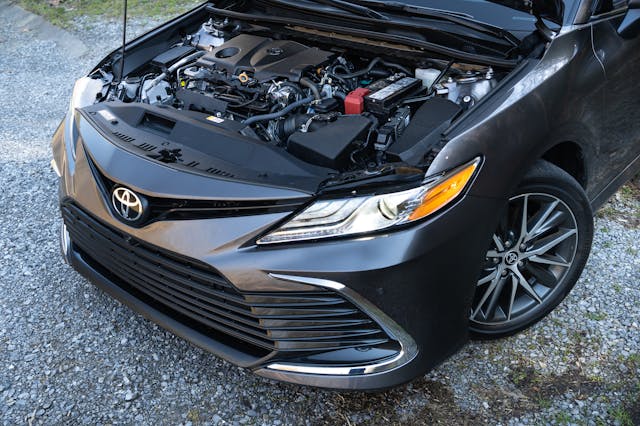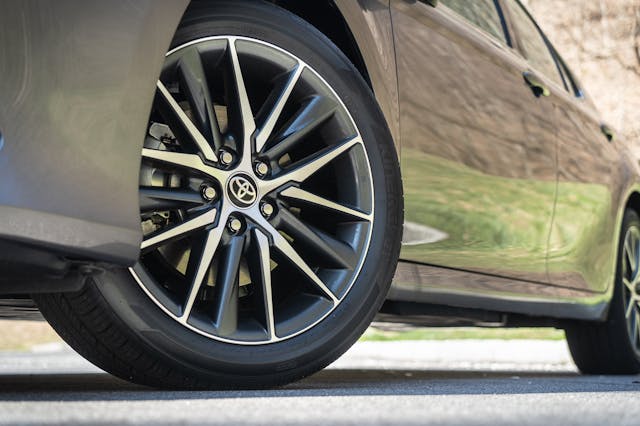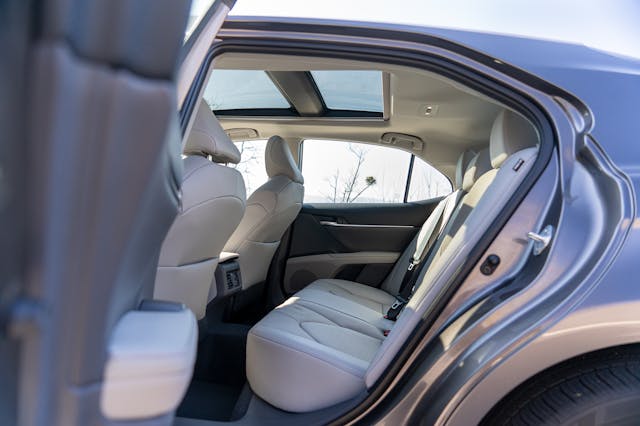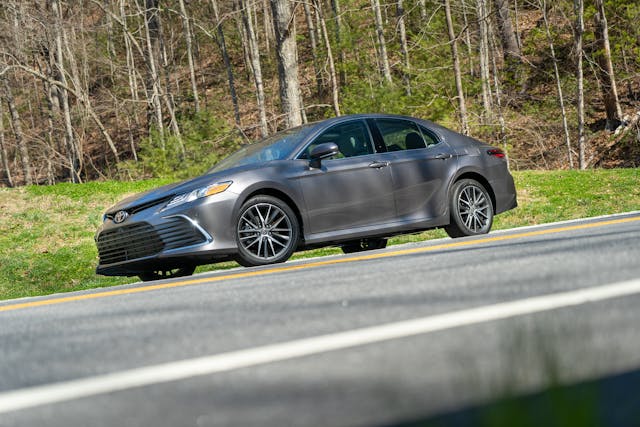Media | Articles
Review: 2021 Toyota Camry XLE AWD
We have here a review of a Toyota Camry.
Midsize sedan. Plain incarnate. A sales stalwart for the same reason that people buy underwear, and about as thrilling. You yourself are probably reading these words and thinking, “If he doesn’t say something at least lightly novel in the next ten seconds, I am heading for literally anywhere else on the internet. Maybe celeb gossip. Amazon reviews. A YouTube video from that ad agency disguised as a content house, where some engaging bearded type will read me incorrect wiki facts about a car I love.”
But that stuff is all … awful, I say.
“At least it’s not a Camry,” you offer.
Alternately, you could stick around a moment and discuss a machine about as metal as plain yogurt.
A stand-up comic whose name escapes me once noted that if you take everything too seriously, nothing is ever serious enough. Conversely, he said, if we dunk on everything, same problem.
Along the same lines, a relatively famous American journalist once wrote a story mocking a particularly well-engineered but dorky minivan.
“Look at you,” he seemed to be saying, all glee and clever, “Sexy as a dugong! For families, even! Who wouldn’t make fun of you?”

What good ever came from punching down? Some extremely smart people I know have solved their driveway with a minivan. Or with a famously durable Japanese four-door of remarkable resale value but khaki-pant personality. For a certain set of the population, these products are merely the best solution to a problem. More to the point, in an age when most vehicles are inefficient little sea-cow trucklets with only a veil of “simplest answer” engineering practice, why belittle people for smart choices?
Ah ha, you think! I’m onto your game!
Oh? says the narrator.
Next, you will tell me the new Camry is the exception! No longer dull as old socks!
Nah.
But for a dull car, this thing is a grade-A stud.

We are gathered here to discuss the 2021 Toyota Camry XLE AWD. AWD as in All-Wheel Drive, a feature new to the Camry for 2020. This system, available only on four-cylinder models, adds just $1400 and 165 pounds. Its electronically controlled electromagnetic coupling can send the Toyota’s rear wheels up to 50 percent of available engine torque. Suspension tuning is shared with two-wheel-drive, four-pot Camrys. Cosmetics are unchanged save a new trunk badge. Car and Driver says rear-seat headroom drops by 0.4 inch. The fuel tank is almost a gallon and a half smaller than on a standard Camry, at 14.4 gallons; parasitic losses also rob 3 mpg from the EPA’s combined fuel-economy rating.
None of this is seductive. Sex is not the point here, just as sex is not the point at an Arby’s. Toyota’s press release calls the standard 2.5-liter, 202-hp four-cylinder “a strong but smooth operator.” The word “strong” is perhaps light exaggeration, but the line is also nice symmetry for those of a certain age, because anything that recalls a Sadé song also makes tired old parents like myself feel like a calm 1980s person with zero desire to yell at traffic after a five-year-old child has dumped her milk in her lap for the third time this morning.

If there is anything that your author wants in this life more than a McLaren F1 GTR, it is probably permission to be still. A 200-horse four cylinder lugging around 3500 pounds of car is an oddly effective form of sign-off.
Normality abounds. The view over that broad hood is neither immediately identifiable nor in any way provocative. Camry cabins grow nicer every year, more and more like a Lexus minus the detail work, and this one is no exception. The clear and sharp TFT infotainment touchscreen (new and improved this year, and available in either seven- or nine-inch size, depending on trim) offers two actual knobs and only eight buttons. The system they control would not be found confusing by a toddler; chalk one up for fad-free sanity in U.I. design. The optional nine-speaker JBL stereo on our test car ($1760, as part of the navigation package) sounded decent, if a bit heavy on the bottom. High volume made a piece of trim rattle somewhere in the back seat.

Highway driving produces only slightly more wind and tire noise than you would get sitting in your house. Most people own couches less supportive than those seats. Our test car wore the optional $1360 panoramic glass roof; rear headroom was tight for your 5’10” narrator, but the rest of the car was clearly designed to fit almost everybody.
Average stuff, really.
Predictably, the Toyota never wants for traction. Wheelspin is nonexistent, even on camber-schizo back roads or when the inside tires are suddenly unloaded. The rear wheels spend most of their lives undriven, but launches and tight corners cause a noticeable shuffling of torque. Tight and climbing first-gear corners can produce the occasional rear-wheel scrabble—a sort of skrup! noise as a lifted rear wheel scrubs on landing, having been given a dusting of torque before touchdown. The steering has feel, but not so you’d notice.
On balance, the chassis is maybe a smidge less lively than the average front-drive Camry. In return for these payments, you get the wet-weather traction of an elephant.

You will die before you find a part of this car that genuinely gets in the way. Power delivery is best described as present, the engine tuned for midrange but game at high rpm if you insist. The eight-speed, Aisin-built automatic shifts neither slowly nor quickly; it’s adequate for normal driving, if occasionally asleep when you need. It reminds you of Japanese automatics from the 1990s, or maybe a dog eating a Kong full of peanut butter, in that communication attempts are generally futile and the object in question seems happier when left alone to confuse itself with the job at hand. The available modes—Eco, Normal, Sport—make the transmission smooth and short-shifting, smooth with the occasional lurching downshift, or lightly aggro with more intense lurching, respectively. So you mostly leave it in Eco.
The engine sounds like an ordinary four-cylinder, heavily dampened in intake and exhaust. A few creeping hints at personality eke out of the muffler at the top of the tach, but then the gearbox shifts and they go away.
In short, an all-wheel-drive Camry of the moment does as all Camrys since time began: As you hustle down a back road, there’s something about how the rear axle works, how the mass settles as the car gradually situates itself into a corner.
You are encouraged, above all, to calm down.
If you do, the machine disappears.

Employment in car journalism means that you meet a metric boatload of automobiles. Maybe one in 20 are so good at their job as to vanish around you. This ideal grows more uncommon by the day. When the SUV-crossover boom hit high gear years ago and sedan sales began to tank, the remaining traditional four-doors seemed to double down on focus. Product planners aimed those cars more at their respective niches—the sporty ones grew more sporting, the luxe ones more luxe, and so on.
In the middle of all that, at almost 300,000 American units sold last year, lives the Camry. All-wheel drive just makes the car more itself, and that itself is the nobility of the ordinary. There is here no sense of finally letting your inner vagabond take the wheel, no hauling of roof tents to Death Valley, no optional rock-crawling accessories or flashy hybrid badging. There is no hybrid system on offer, period; Toyota offers a Camry Hybrid, but you can’t buy one with all-wheel drive. Probably because at that point, you’d have something like Toyota’s own Highlander Hybrid, just lower to the ground and more subtle about its talents. Subtlety is a hard sell these days.

Grab the keys here, you embrace a few truths. Statistically speaking, a Camry will run virtually forever at minimal cost, until the arrival of either a catastrophic oil leak or the heat death of the universe. (Equally likely, really.) You will not have to explain to anyone why you bought this particular Toyota, and no one will bother to ask. You will simply spend your miles with a thoroughly unpretentious piece of quiet mobility, a longtime people’s champion of trunk and interior space. A machine beloved by million-mile cab drivers, fleet managers, and mild-mannered traveling salesmen named Gerald.
Only now that legend can be had with four driven wheels, not just two.
How exciting!
2021 Toyota Camry XLE AWD
Base price/as-tested: $32,265 / $37,224
Highs: It’s a Camry with all-wheel drive. Abhor loud noises and attention? Prize quiet competence, resale value, and traction? This is your huckleberry.
Lows: Only available with the four-cylinder. Not a quick baby, as my mother used to say, even by Camry standards. Fuel economy takes a hit compared to front-drive models.
Summary: The best-selling passenger car in America, now more dialed for wet weather. They’ll probably sell in the Northeast.


